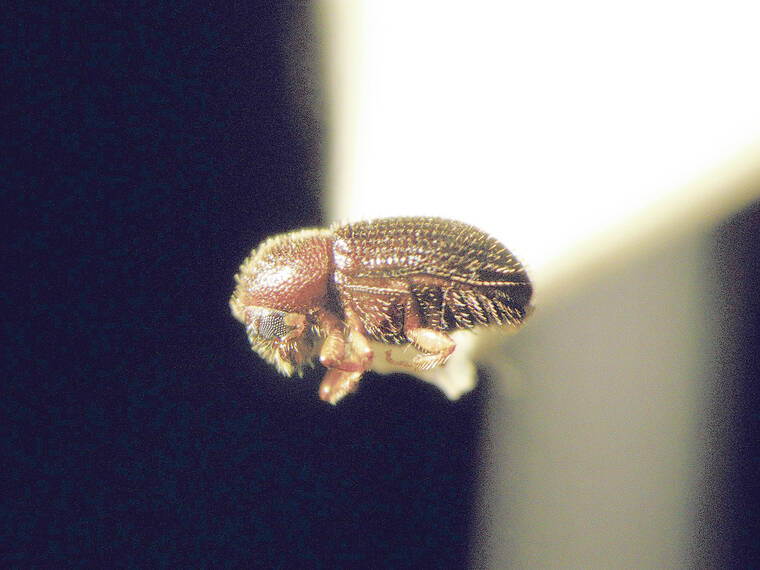LIHU‘E — Two threats to local coffee trees have spread across the island, rapidly circulating after their first recorded appearances on Kaua‘i.
The coffee berry borer (Hypothenemus hampei), a pestilential beetle, was initially identified on Kaua‘i in September 2020. True to its name, CBB drill into coffee berries to build galleries for its larvae, spoiling the seed. The bug’s initial range covered seven properties in a half-mile radius spanning Kalaheo and Lawa‘i. It has since been reported as far north as Moloa‘a.
Farmers were then hit with the second blow of a one-two punch less than one year later, when coffee leaf rust (CLR) caused by the fungus Hemileia vastatrix was confirmed in Kilauea this past June. Coffee leaf rust, which blights leaves and can kill trees, has been confirmed in Kalaheo, Puhi and the upper Wailua area since then.
Agricultural pests have been top of mind this autumn. Just last week, state and local experts updated the public on the little fire ant (Wasmannia auropunctata) infestation undergoing treatment in Moloa‘a. But unlike those pests, which can potentially be eradicated on Kaua‘i, CBB and CLR are here to stay.
On Wednesday, the state Department of Agriculture, Kaua‘i Invasive Species Committee and University of Hawai‘i personnel said growers must adopt new procedures to mitigate the invasive species’ impact, offering advice and assistance.
“You can see the spread of CBB did not happen overnight,” DOA pest-control specialist Craig Kaneshige said. “Our surveys now indicate that coffee berry borer is established at different locations. Integrated pest management must be used to control this infestation.”
Integrated pest management for both pests will mean more work for growers intent on protecting their harvests. Coffee trees must be strip-picked prior to the growing season to remove berries potentially filled with berry borers, and CBB traps should be used as monitoring tools.
New pruning and spraying techniques also have roles to play. The removal of excess branches improves airflow around each coffee tree, discouraging the dampness preferred by CLR. It also increases sprays’ available coverage area.
UH College of Tropical Agriculture and Human Resources Extention Agent Andrea Kawabata prescribed a litany of pesticides and fungicides on Wednesday, noting farmers should not rely upon a single product.
“Make sure you’re calibrating your sprayers using the proper pesticides and proper rates, following the frequency work recommendations, as well as rotating between the different fungicides so that we avoid pesticide resistance,” Kawabata said.
Farmers and researchers have limited tools in their fight against CLR, according to Kawabata. If the fungus becomes resistant to spray, there is nothing to fall back upon.
“So we are encouraging growers to rotate their products now so that we do not get into that problem of resistance,” she said, noting the identification and propagation of CLR-resistant coffee varietals are long-term solutions still under development.
Experts highlighted resources available to those affected by CBB and CLR. According to UH-CTAHR and KISC representatives, a “rapid-response team” may remove small-scale infestations in certain situations.
KISC Project Manager Tiffani Keanini instructed attendees to email KISC@hawaii.edu for more information.
“We can work with you to see what capacity you need to survey your farm, or do some monitoring and help provide some information if we can’t help with the full capacity that you need,” Keanini said.
DOA also has a CBB subsidy program, and a CLR subsidy coming next month.
“And again, this is in addition to the (existing) CBB subsidy,” Kawabata said. “So, if you’ve already been spraying for coffee leaf rust, hang on to those original receipts.”
The CLR subsidy program is tentatively scheduled to begin Nov. 1 or sometime thereafter. Applicants can receive an annual 50% reimbursement of CLR fungicide costs up to $600 per acre, with a cap of $6,000 per farm. Applicants are directed to contact Melanie Bondera at hdoa.cbb@hawaii.gov or call 808-32-7578 for more information.
Kawabata and colleagues’ research and recommendations regarding CBB and CLR can be viewed at hawaiicoffeeed.com.
•••
Scott Yunker, general assignment reporter, can be reached at 245-0437 or syunker@thegardenisland.com.






Can coffee berry borer & rust impact more plants than just coffee? Our kabocha pumpkin & lilikoi plants are being eaten by bugs & the leaves are turning to lace. The pumpkins look like it’s the coffee berry borer boring into the baby pumpkins when comparing to online photos.
How did this insect come from Africa to Hawaii? Seems like our Agriculture Inspector are not doing a great job of watching out for evasive insect entering the islands.
Africa is a far way from here!